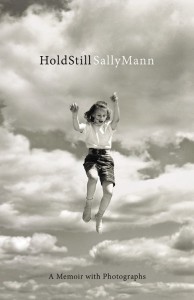This review is by contributor Thuy Dinh, editor of Da Mau Magazine.
 The cover photograph of Sally Mann’s memoir, Hold Still, shows the author as a prepubescent tomboy, airborne against a gray expanse of sky. She seems suspended outside of time, as if she could be from any decade: her hair, white T-shirt, and preppy plaid shorts belong as much to the first decade of the 21st century as to the middle of the last century. This cover image of Mann brings to mind her gorgeous yet controversial black and white photographs of her children in Immediate Family—naked water sprites from a lost, ahistorical Eden.
The cover photograph of Sally Mann’s memoir, Hold Still, shows the author as a prepubescent tomboy, airborne against a gray expanse of sky. She seems suspended outside of time, as if she could be from any decade: her hair, white T-shirt, and preppy plaid shorts belong as much to the first decade of the 21st century as to the middle of the last century. This cover image of Mann brings to mind her gorgeous yet controversial black and white photographs of her children in Immediate Family—naked water sprites from a lost, ahistorical Eden.
Here’s the shocker: Mann thinks photographs have the power to distort, or worse, supplant a person’s memory.
Photography would seem to preserve our past and make it invulnerable to the distortions of repeated memorial superimpositions, but I think that is a fallacy: photographs supplant and corrupt the past….As I held my childhood pictures in my hands…I also knew that with each photograph I was forgetting.
The thematic tension in Hold Still reflects Mann’s two life-long passions: the static romance of photography and the dynamism of the written word. Central to this tension is Mann’s identity as a Southern artist deeply burdened by her forebears’ past with slavery.
Mann’s memoir celebrates the natural beauty of Lexington, Virginia—her birthplace—yet it also acknowledges the region’s ingrained racism. Mann recounts being raised mostly by Virginia (Gee-Gee) Carter, her family’s black housekeeper. While she loved and respected Gee-Gee, she now realizes that neither she nor her parents, who were considered kind employers, ever questioned the segregation practice that was prevalent at the time. No one inquired whether Gee-Gee, who worked 12 hours a day, 6 days a week for Mann’s family, besides taking in the neighborhood’s laundry to supplement her income, had time to eat or feed her own family.
By juxtaposing photography’s selective truth with her family’s blinkered complacency on the question of race, Mann offers her stark narrative as atonement. She poignantly observes how often real life is too large, too complex, to be framed by image.
Nevertheless, Hold Still affirms the questing nature of art, how art challenges calcified assumptions and in so doing forges new paths. Mann resurrected the past in her decision to use wet collodion plates for her Deep South project. Air bubbles, dust motes occurring in this painstaking process—where chemicals had to be applied directly onto the glass plates—became “blessings from the angel of uncertainty” who bestowed “persuasive consequence, intrigue, drama, and allegory.”
These marks of imperfection represent the fluidness of art that liberates it from staticity, hewing it closer to life, or what Mann describes poetically as meuse, a word that describes a hare’s bodily imprint on the grass, closely connected to the word Muse, daughter of Memory.
Hold Stil beautifully demonstrates that an artist’s personal history is inseparable from her artistic self. In this indelible memoir, carefully curated with family snapshots and preserved memorabilia, Mann shows that her obsessions with the artistic process, family, race, and death are traits inherited from several of her guilt-ridden ancestors, who were vexed either by unmet desires or by the slavery issue.
Seen in this light, the resplendent images of her long-ago nude children are not so much provocative as wistful. Mann has always known that American innocence is a fictional construct, created out of deep longing, struggle, and isolation.







2 Comments
Eirego
May 18, 2015 at 10:06 amI’ve been hearing a lot about this book and have purposefully ignored most of it. I also sidestep stories about the free range kids’ parents, both by the proponents and the detractors. Not being a parent, I don’t feel my opinion should or could matter. I do applaud Sally Mann, and anyone willing to express themselves via an art form, no matter how controversial. It gets people talking and that’s what art is supposed to do.
lauren
May 18, 2015 at 1:00 pmGreat review, Thuy, I am now very intrigued by Mann’s current offering. Particularly so after reading you speak to her photographic process. I am a vociferous anti-Photoshopper, as I believe the constant need to have things look “perfect” distorts the beauty of reality, particularly with respect to the human form. I look forward to picking this one up, thanks for the thoughtful review.